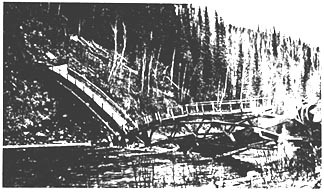

The Davidson Ditch
Driving north from Fairbanks on the Steese Highway, it is possible to see two pipelines. One is bright and shiny and carries oil; the other is old and rusted and carried water years ago. They are both remarkable examples of engineering for their day.
The rusty pipe, almost exactly the same diameter (46 to 56 inches) as the Trans-Alaska Pipeline (48 inches), represents the remnants of a project undertaken during the years 1924 to 1929 to bring water to the Fairbanks area gold mining operations. The operation was carried out under the auspices of the Fairbanks Exploration Company (known locally as F.E.), a subsidiary of United States Smelting, Refining and Mining Company (U.S.S.R. & M.).
This project, known as Davidson Ditch, was a 90-mile-long conduit designed to divert water from the Chatanika River at a point below the junction of Faith and McManus Creeks to hydraulic sluicing (stripping) operations at Cleary and Goldstream, just north of Fairbanks. The term "ditch" does not do the project justice because, although the open earthwork section comprised most of its length, the course included a 0.7 mile long tunnel near Fox, and 6.13 miles of inverted siphons along the way. (Anyone who has tried to suck gas from a gasoline tank and drain it into a bucket through a hose knows what a siphon is. It carries fluid over a high point into a lower one. An inverted siphon carries fluid across a low point--in this case, a stream bed, back to a higher one.)
The inverted siphons, which are the pipes visible today, were masterpieces of engineering at the time. There were fifteen in all, crossing ridges and the creek beyond. The longest was a 7,961 foot section which crossed the Chatanika River with a head of 544 feet (the reason that Chatanika water crossed above its source river downstream from the inlet is that the Davidson Ditch had a gradient of only 2.112 feet per mile, whereas the river's gradient is significantly higher).
The accomplishment of the men who completed this project is made all the more special because at the time, very little was known about the construction and maintenance of large ditches under the circumstances prevailing in the permafrost areas of the Fairbanks area.
It is interesting to note that construction was completed before the advent of the bulldozer. Earth moving was performed primarily by tractors, graders, and steam and diesel shovels. The steam shovels had been previously used in construction of the Panama Canal.
Material for this article has been excerpted from the book, History of Alaskan Operations of U.S.S.R. & M. written by John C. Boswell and published by the Mineral Industries Research Laboratory of the University of Alaska.






